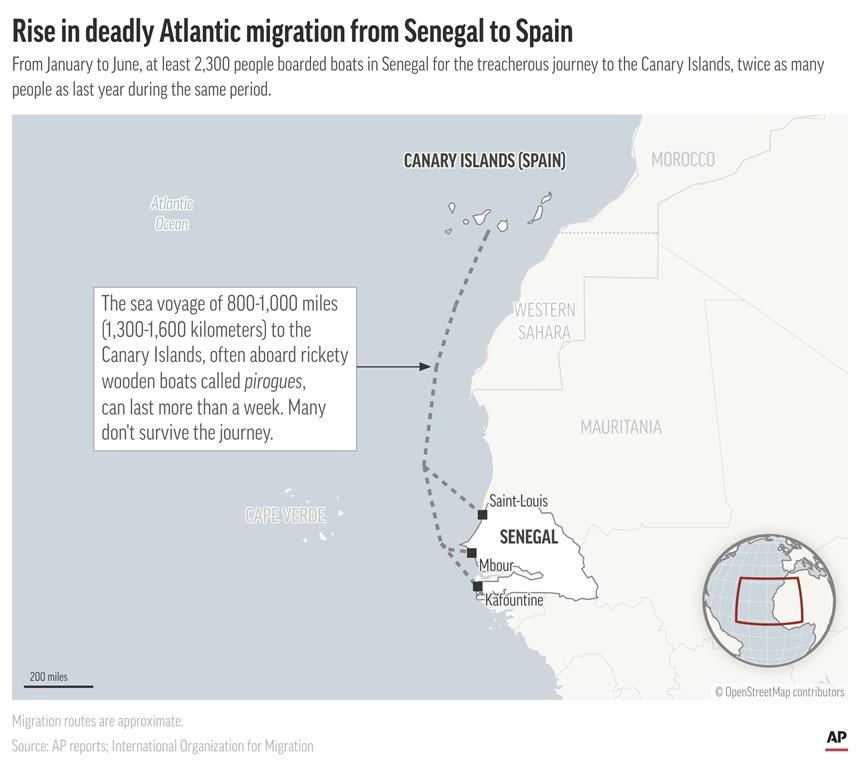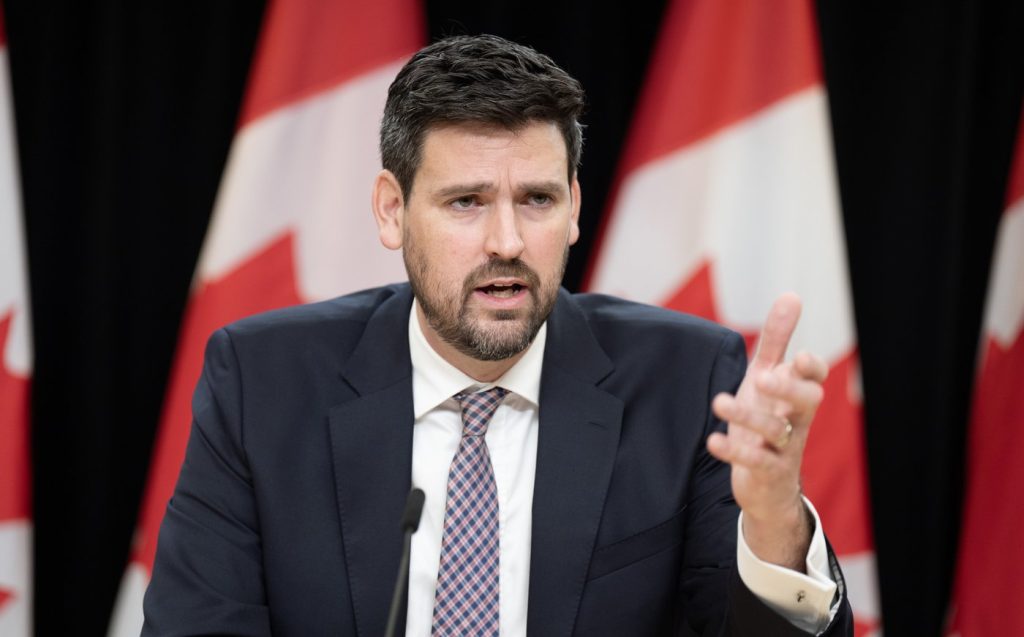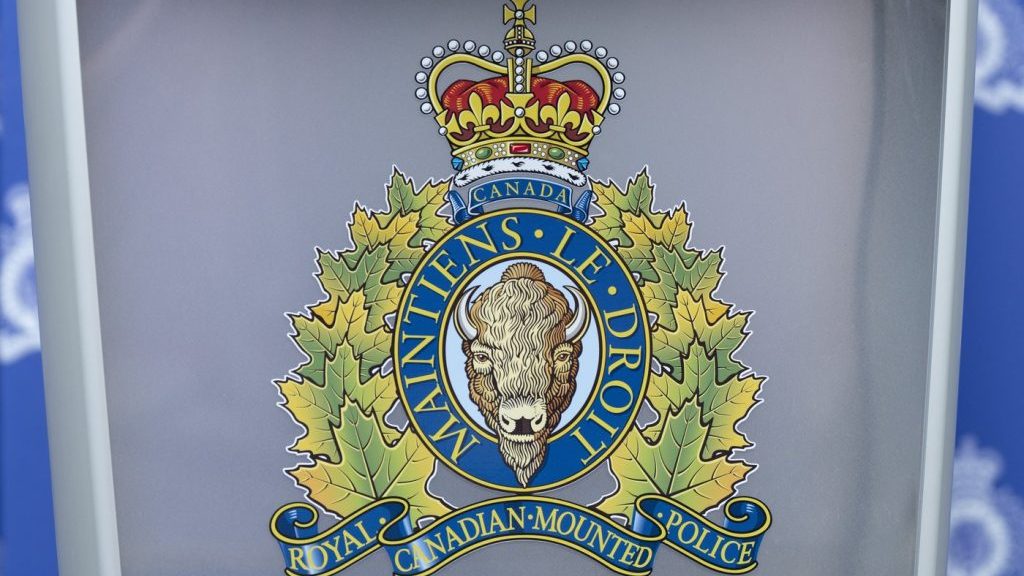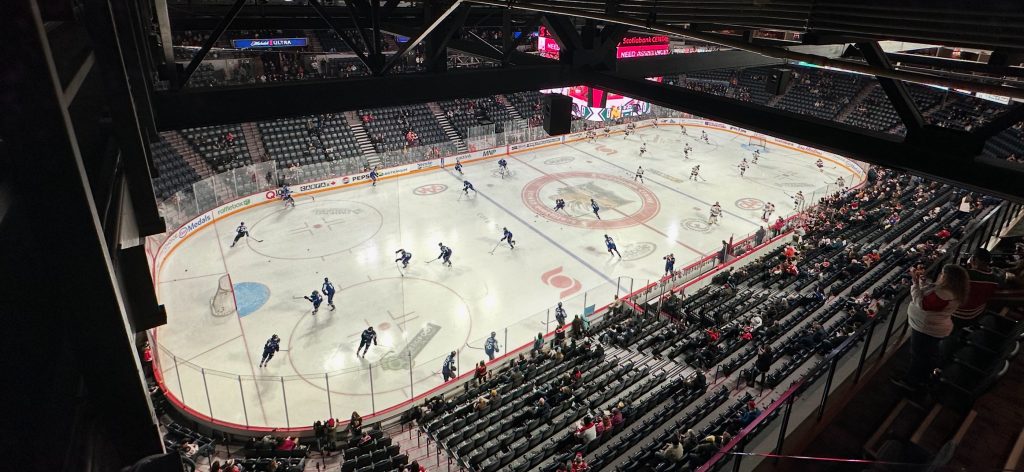Unmarked Senegal beach graves hold untold number of West African migrants, officials and locals say

Posted Jul 28, 2023 08:45:32 PM.
SAINT-LOUIS, Senegal (AP) — The small mounds of sand that dot the beach in northern Senegal blend into the terrain. But thick rope juts out from beneath the piles. Pieces of black plastic bags are scattered nearby, and green netting is strewn on top.
That’s how residents in the small fishing town of Saint-Louis say they know where the bodies lie.
These unmarked beach graves hold untold numbers of West African migrants who are increasingly attempting the treacherous journey across parts of the Atlantic to Europe, Senegalese authorities, residents along the coast and survivors of failed boat trips told The Associated Press.
Bodies wash ashore or are found by fishermen at sea, then are buried by authorities with no clarity as to whether the deaths are documented or investigated as required by Senegalese and international law, according to lawyers and human rights experts. Most of the families of those buried will never know what happened to their loved ones.
The route from West Africa to Spain is one of the world’s most dangerous, yet the number of migrants leaving from Senegal on rickety wooden boats has surged over the past year. That means more missing people and deaths — relatives, activists and officials have reported hundreds over the past month, though exact figures are difficult to verify.
The increases come amid European Union pressure for North and West African countries to stop migrant crossings. Like most nations in the region, Senegal releases little information about the crossings, the migrants who attempt the trip or those who die trying.
But according to the International Organization for Migration, at least 2,300 migrants left Senegal trying to reach Spain’s Canary Islands in the first six months of the year, doubling the number from the same period in 2022. A Spanish official, speaking on condition of anonymity because the figures weren’t authorized for release, told AP that about 1,100 arrived in the Canaries.
It’s unclear what happened to the 1,000-plus people who didn’t make it to Spain. They may have died at sea, been rescued from capsized boats or be held by authorities. Through June, Senegal detained 725 migrants, said interior ministry spokesman Maham Ka, though officials wouldn’t say whether the nine vessels involved had left shore yet.
Authorities in Saint-Louis admitted to AP that bodies are sometimes buried on the beach. They said it happens only when approved by the local prosecutor — and usually the bodies are severely decomposed.
“Why take it to the morgue since no one can recognize it?” said Amadou Fall, fire brigade commander for three northern Senegal regions.
The prosecutor in Saint-Louis wouldn’t respond to questions about approval of burials or say whether investigations were opened into the deaths. AP phoned and texted Senegal’s justice ministry, responsible for investigating deaths, but received no response.
For families, the silence can be agonizing. Mouhamed Niang’s 19- and 24-year-old nephews went missing a month ago. He filed missing-person reports, he said, but got no updates from authorities. Friends alerted him when boats were recovered or bodies washed ashore. He’d make the three-hour bus trip from Mbour north to Saint-Louis to check with officials or visit the morgue.
He told AP he knows about the bodies on the beach. His worst fear: that the young men were among them.
“They are human beings,” Niang, 51, said. “They should be buried where human beings are buried.”
________
If the journey goes smoothly, reaching Spain takes about eight days from Saint-Louis on pirogues — long, colorful wooden boats. Saint-Louis, bordering Mauritania, is a key hub for departures. There, the beach is now marked in parts with remnants of the black plastic resembling body bags from the morgue and the knotted rope that appears to secure what lies beneath the sand.
In recent years, the Canary Islands have again become a main gateway for those trying to reach Europe. Previously, most boats traveled from Morocco, Western Sahara and Mauritania, with fewer from Senegal. This year, that changed. The Spanish official who spoke to AP said numbers from Mauritania plummeted last year following pressure by local authorities with on-the-ground Spanish support. When one route is cut off, migrants tend to look for alternatives, even if they’re longer and more dangerous.
Senegal has long been regarded as a beacon of democratic stability in a region riddled with coups and insecurity, but tension is mounting, with at least 23 killed last month during protests between opposition supporters and police. Some cite political strife for surging migration; others note that most who leave are young Senegalese men who say poverty and a lack of jobs drive them.
“There’s no freedom in Senegal,” said Papa, 29, who made it to the Canaries this month after a boat journey during which the engine failed, food ran out and fights erupted.
He said he’s seeking asylum in Spain because of Senegal’s political problems. He described police shooting at people like him who took to the streets to oppose President Macky Sall. He and others among the hundreds of Senegalese who made it to the Canaries in recent weeks blamed unemployment, a struggling economy and rising food prices on Sall’s administration.
“The salaries are not good, rice is too expensive. You need a lot of money to eat,” said Papa, who has two wives and children to feed in Senegal. Wearing a bracelet with the name of opposition leader Ousmane Sonko, Papa gave only his first name, citing fears about deportation.
Since 2006, Spain has worked with Senegal to crack down on migrant boats. That year, Canaries arrivals first peaked, with 30,000-plus people — many of them Senegalese. Today, Spain’s national police and civil guard are deployed in Senegal to assist local authorities. Senegal also received more than $190 million from the EU’s Emergency Trust Fund for Africa for programs aimed at addressing the root causes of migration.
But residents here say little has improved.
From May to July, about 30 boats left Saint-Louis for Europe and about 10 sank, said El Hadji Dousse Fall, of the Organization for the Fight Against Clandestine Immigration, which tries to prevent youths from crossing the sea and teaches them about legal migration pathways. Still, many have already made up their minds.
“They have a saying,” Fall said, speaking partly in the local Wolof language. “Barca or Barsakh” — Barcelona or die.
Senegalese officials won’t give data on how many people are unaccounted for trying to cross that stretch of the Atlantic. Sometimes, they refute reports of missing people — this month, Spanish rights group Walking Borders rang the alarm that 300 Senegalese were missing, and the government called the statements unfounded.
The beach burials have happened for years but skyrocketed for 2023, with about 300 bodies in the first seven months, compared with just over 100 for all of 2022, according to a local official who works closely with authorities and insisted on anonymity for fear of reprisal.
Locals say the government tries to hide the scale of the problem because it tarnishes Senegal’s reputation.
“It’s a sign of failure that undermines the government’s public policy record,” said Alioune Tine, founder of West African think tank Afrikajom Center.
____
During a visit to Saint-Louis, AP spoke with two survivors of attempted trips. The men departed within days of each other, from Mbour in early July. Both boats got lost and capsized at the mouth of the Saint-Louis river, where waves swell and conditions can turn volatile. One survivor saw another boat capsize minutes after his.
The men said that of about 420 people aboard the three vessels, roughly 60 were rescued.
Ibnou Diagne, 35, said the boat capsized days into the trip. He watched a piece of broken boat wood ram into the stomach of a teenage passenger, stabbing him before he fell into the sea.
But what haunts him most are memories of his longtime friend Abdourahmane, who drowned. “Everyday when I sleep, it’s Abdourahmane’s image and face that emerge in front of me,” he said.
The other survivor said he fled after the rescue — he was taken for questioning but got out of the car and hid. On condition of anonymity for fear of being detained again, he described waking at 4 a.m. to his boat being launched in the air upon hitting a giant wave.
Thrown into the water but able to swim, he anchored himself to a smaller nearby vessel and waited for rescue. Two friends who boarded with him drowned. Days later, he called their mothers to tell them their sons were dead. Without him, he said, the families would have no idea what happened to the men.
Senegal has agreed to several international accords, including The African Charter on Human and Peoples’ Rights and The Global Compact on Migration, to ensure the investigation of disappearances and arbitrary deaths, identify the dead, and inform families.
Even if a body has decomposed, the obligation remains to do everything possible to identify the person and seek support if resources are lacking, said Judith Sunderland, of Human Rights Watch.
“It’s completely unacceptable for state authorities to bury people without investigating the causes of their deaths or attempting to identify them,” she said.
Boubacar Tiane Balde, chief of the anti-smuggling regional branch in Saint-Louis, said stemming the tide of migration is challenging, with new cases daily. And smugglers, paid by migrants to get across the border, are embedded in the community.
“The biggest difficulty is first to have clear information,” Balde said. “Not everyone is willing to collaborate.”
Some say officials aren’t serious about cracking down. Many boats bribe authorities on the water, sometimes paying $1,700 to get through, said a smuggler who insisted on anonymity over fears for his safety. To stay undetected, he uses smaller boats to shuttle passengers so it appears they’re just fishing, he said, and for safety, he’s cut the number of passengers allowed to 80 from 140.
Such measures come as little comfort to those with missing relatives.
During Niang’s fourth visit to Saint-Louis to look for his nephews, he was called to the morgue. But the men weren’t there. Later, authorities reached out to their mother, Niang’s sister. They wanted her and her husband to make a photo identification. Based on a ring and his long hair, they knew the body was their son.
They still don’t know the fate of his brother. They aren’t alone in their grief, but that brings little solace.
“Every day I see people looking for relatives lost at sea,” Niang said. “Some of them conduct funerals without the bodies.”
The family will travel to Saint-Louis, then bring the body home. They’ll hold one funeral, with prayers for both brothers.
___
Brito reported from Barcelona and Las Palmas de Gran Canaria, Spain.
Sam Mednick And Renata Brito, The Associated Press








